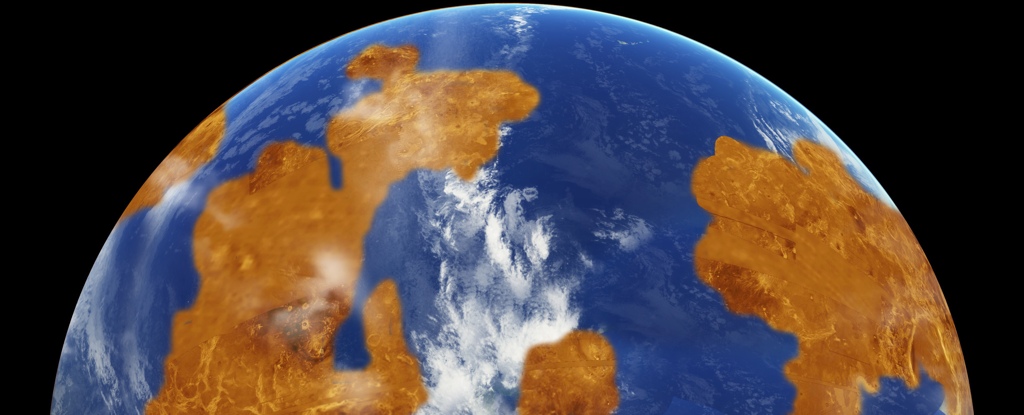
Venus may be one of the brightest and most beautiful objects in our night sky, but don't be fooled.
Our neighboring planet is deeply inhospitable to life as we know it – a toxic, scorching world on which humans will never be able to tread.
In spite of the differences in habitability, though, Venus shares some striking similarities with Earth. Both planets are around the same size, mass, and density, and have very similar compositions. This raises the question: Could Venus ever have been habitable?
A new study has found that if Venus ever did have habitable conditions, and liquid water on its surface, it was a long time ago, and lasted only briefly before the planet transformed into the parched, arid world it is today.
Planetary scientists Alexandra Warren and Edwin Kite of the University of Chicago modeled the history of Venus' atmosphere to determine the rate and mechanisms of oxygen loss – which in turn revealed that if the planet ever did have liquid water (which some scientists doubt), it was over 3 billion years ago.
Here's what Venus is like now. It's extremely dry, and extremely low in oxygen. Its atmosphere is 96 percent carbon dioxide, and 3 percent nitrogen, with trace amounts of other gasses, such as sulfur dioxide.
Its atmosphere is extremely thick, with pressure over 90 times that of Earth's, wracked by powerful winds and raining sulfuric acid.
And because its atmosphere is so thick, heat can't escape. Venus has the hottest surface temperature of any planet in the Solar System, at an average of 464 degrees Celsius (867 degrees Fahrenheit).
Earlier in the history of the Solar System, when the Sun was less powerful, Venus may have been more temperate, with lakes and oceans of liquid water.
Planetary scientists want to know how and why Venus got to the condition it is now; since Venus is so similar to Earth – with some climate models suggesting Venus could have had water as recently as less than a billion years ago – working out its history could help us figure out how likely our home planet is to follow the same path.
The lack of oxygen in Venus' atmosphere is a bit of a puzzler. If the planet ever did have a liquid ocean, that water would have evaporated into the atmosphere as Venus heated up, breaking up into hydrogen and oxygen via photodissociation, a chemical reaction triggered by sunlight.
The hydrogen would have leaked out into space, but the oxygen should have remained.
Warren and Kite wanted to know where that oxygen could have gone, so they constructed a model based on a habitable Venus. They put water oceans on Venus' surface, added mechanisms that could have contributed to oxygen loss, and tweaked parameters such as the amount of water, and the timeframe in which it could have been present.
They let the model run 94,080 times, considering it successful if the dioxygen, water, and carbon monoxide levels at the end of the run were within the upper limits on those gasses in Venus' atmosphere today.
In the end, only a small percentage of the model runs were successful, and they showed some interesting trends.
One possibility is that Venus' oxygen became bound up in carbon emitted by volcanoes to form carbon dioxide, but this seemed to be pretty improbable.
Rather, the oxygen seemed most likely to suffer one of two fates: to leak out into space, or become sequestered in oxidizable magma, such as basalt, on the planet's surface. And the oceans need to have dried up no more recently than 3 billion years ago.
But the magnitude of Venus' past volcanic activity can be constrained by the amount of radioactive argon still present in the planet's atmosphere. By determining how active Venus' volcanism was in the past, the researchers were able to estimate how much water the planet could have had.
The answer is not much. Venus' oceans could have been no more than 300 meters (984 feet) deep. That's less than 10 percent of Earth's average 3,688-meter ocean depth.
So the results reconcile the lack of oxygen in Venus' current atmosphere with potential early habitable conditions, but the loophole, the researchers say, is a narrow one.
That loophole becomes even narrower when the argon record is considered. Less than 0.4 percent of the runs were successful when taking the entire scope of Venus's current atmosphere into account.
Future missions could try to measure the composition of Venus' surface to help determine if the planet did indeed fall into this very narrow loophole.
The research has been published in Proceedings of the National Academy of Sciences.
https://news.google.com/rss/articles/CBMiXWh0dHBzOi8vd3d3LnNjaWVuY2VhbGVydC5jb20vb2NlYW5zLW1heS1oYXZlLW9uY2UtZ3JhY2VkLXZlbnVzLWJlZm9yZS1pdC1iZWNhbWUtYS1oZWxsLXBsYW5ldNIBAA?oc=5
2023-03-13 05:26:38Z
CBMiXWh0dHBzOi8vd3d3LnNjaWVuY2VhbGVydC5jb20vb2NlYW5zLW1heS1oYXZlLW9uY2UtZ3JhY2VkLXZlbnVzLWJlZm9yZS1pdC1iZWNhbWUtYS1oZWxsLXBsYW5ldNIBAA
Bagikan Berita Ini















0 Response to "Oceans May Have Once Graced Venus Before It Became a Hell Planet - ScienceAlert"
Post a Comment